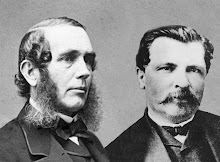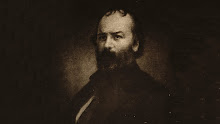My work on Currier & Ives: Perspectives on America comes to an end this week with a final report to our generous funders, Partnership for a Nation of Learners, the Institute of Museum and Library Services, and the Corporation for Public Broadcasters. In that documentation, I am proud to report that we have fulfilled our objectives and even surpassed some goals. In particular, securing national distribution was a real boon for the exposure of Springfield's efforts to make a local treasure a broader educational resource. The nationwide broadcast of the series goes beyond the requirements of the grant and importantly, it ensures that more people know about the importance of Currier & Ives and how their lithographs may be used effectively and easily as a vivid window to 19th century America. The focus of this project was always about education, not promoting one particular collection, and the national broadcast is our "cherry on the sundae"!
As I think my blogs reveal, this project has been a joy and a wondrous journey. I'm grateful to WGBY and the Springfield Museums for the opportunity to manage the educational partnership and to serve as Executive Producer of the documentary series. I am especially privileged to have worked with the Currier & Ives collector and expert, John Zak, and Kay Simpson, Director of Education and Institutional Advancement at the Springfield Museums. They have been invaluable partners and unflagging supporters. When I reviewed the documentaries recently, I was astounded by the depth and breadth of images and information that owe directly to the efforts of John Zak. Kay was my closest partner at the Museums and I can never apologize enough for forgetting to acknowledge her work at our biggest screening! I still cringe over that. Kay Simpson is the main force behind the success of our educational efforts and she also served as my teacher, educating me about the partners and the Project when I came on board back in April of 2007. She has always made time in her extremely busy schedule to answer my questions, share information, anticipate challenges, and share a chuckle. What an honor to work with her!
As I've mentioned before, I'm also especially indebted to videographer Mark Langevin and Senior Editor Ray Laferrier for their way-above-and-beyond efforts! I am fortunate to take away several wonderful friendships from my time in Springfield, Massachusetts. I'd like to take this opportunity to also thank Lynn Page and Keith Clark of WGBY for the energy and time they devoted to this effort. Their patience, diligence and talents are simply astounding.
Please keep an eye on our dynamic website for new features. We've wrapped up the edits on the podcasts and they'll be added to the site soon. Teachers will find the podcast Lesson Plans and Learning Activities an easily replicable resource in the classrooms. Students can enjoy the interactive features "What Is A Print?" and "Look Closer!", as well as "My Currier & Ives Gallery". The Museums will continue to train teachers to use the lithographs as a way to teach Visual Literacy and more. The Museums will also make sure DVDs of the documentary series get into the hands of librarians, curators and educators throughout the region and beyond.
As a result of this project, I understand so much more about 19th Century America and I hope you do, too. I've also developed a deep fondness for the work of the two gentlemen who have been my constant companions for 14 months: Nathaniel Currier & James Merritt Ives. I hope we have given the "Printmakers to the American People" the tribute they so richly deserve. And don't say I didn't warn you: you'll find that once you start appreciating these prints and seeking them out, it becomes a bit of an obsession! I have 4 now. As John Zak told me from the start, the collecting bug bites deeply.
I am convinced the grantmakers will agree their money was well spent. I know my time was. It is with a tinge of regret that I end this blog. It's been great fun sharing this producer's journey with you!
- Mary Steele
Tuesday, June 17, 2008
Subscribe to:
Post Comments (Atom)


















5 comments:
And thank you Mary. WGBY and all our partners were very fortunate to have someone of your skill, creativity and integrity to lead and manage a project of this depth, breadth and reach. All your good work is much appreciated.
As videographer of this wonderful series, I too am greatful for the wonderful friendships that have evolved.
The last fourteen months have been an absolute joy.
Mary and John, thank you for evrything. On both a professional and personal level, this experience will never be matched!
Thank you for everything.
See you in Brimfield!
Dear Ms. Steele:
In your blog you wrote: "The nationwide broadcast of the series goes beyond the requirements of the grant and importantly, it ensures that more people know about the importance of Currier & Ives and how their lithographs may be used..."
Currier & Ives lithographs are a canard.
On page 196 of The Random House College Dictionary, "canard" is defined as: "a false story, report, or rumor, usually derogatory; hoax."{2}
Currier & Ives lithographs are actually non-disclosed chromist-made reproductions.
A chromist{3} is someone who copies by their own hand a reproduction of the artist's original work of visual art. Reproduction{4}, by definition, is a copy of an original work of visual art that is done by someone other than the artist.
An early and prime example of a Currier & Ives' non-disclosed chromist-made reproduction is the above titled "Lexington." Despite being printed below the image as "Drawn by W.K. dewitt," it was actually drawn by the chromist Napoleon Sarony in 1840.
This fact is confirmed in the Currier & Ives, Printmakers to the American People by Harry T. Peters. On pages 13 and 14, the author writes: "Napoleon Sarony achieved his fame in activities other than his work for Currier & Ives, but early in his career he was employed as a lithographer by Nathaniel Currier - Sarony's most important work for Currier was the famous Lexington print, which he designed."{5}
In closing, you wrote: "The focus of this project was always about education." Yet, when the above facts and more were presented to your and your WGBY colleagues, you didn't refute the scholarship, you ignored it. Sadly, your Currier & Ives Perspective program, as entertaining as it is, just perpetuated misconceptions and misrepresentations that reproductions are lithographs.
Gary Arseneau
artist, creator of original lithographs, scholar and author
FOOTNOTES:
1. Image from www.springfieldmuseums.org/museums/mfa/collection/search.php?page_function=detail&k=LEXINGTON&page=1&collection_id=3
Text gleaned Plate 21 from Currier & Ives, Printmakers to the American People by Harry T. Peters, 1942
2. Copyright 1980 by Random House, Inc. ISBN 0-394-43500-1
3. Chromist is defined as "One who works with color". an artist craftsman who separates paintings or drawings into individual colors used to print. www.cartage.org.lb/en/themes/Reference/dictionary/artdictionary/c/Chromist%20.html
4. On page 350 in the 1991 HarperCollins Dictionary of Art Terms & Techniques by Ralph Mayer, the term “reproduction” is defined as: “A general term for any copy, likeness, or counterpart of an original work of art or of a photograph, done in the same medium as the original or in another, and done by someone other than the creator of the original.” ISBN 0-006-461012-8 (pbk.)
5. Currier & Ives, Printmakers to the American People by Harry T. Peters, 1942
Excerpt from: http://garyarseneau.blogspot.com/2008/05/currier-ives-lithograph-lie-over-168.html
I would love that you hear some of my beats.
http://darkwood-records.blogspot.com/
Compare Edward Hopper or Charles Sheeler with Currier & Ives
http://www.google.com/search?q=charles+sheeler&tbm=isch
http://www.google.com/search?q=charles+sheeler
Post a Comment